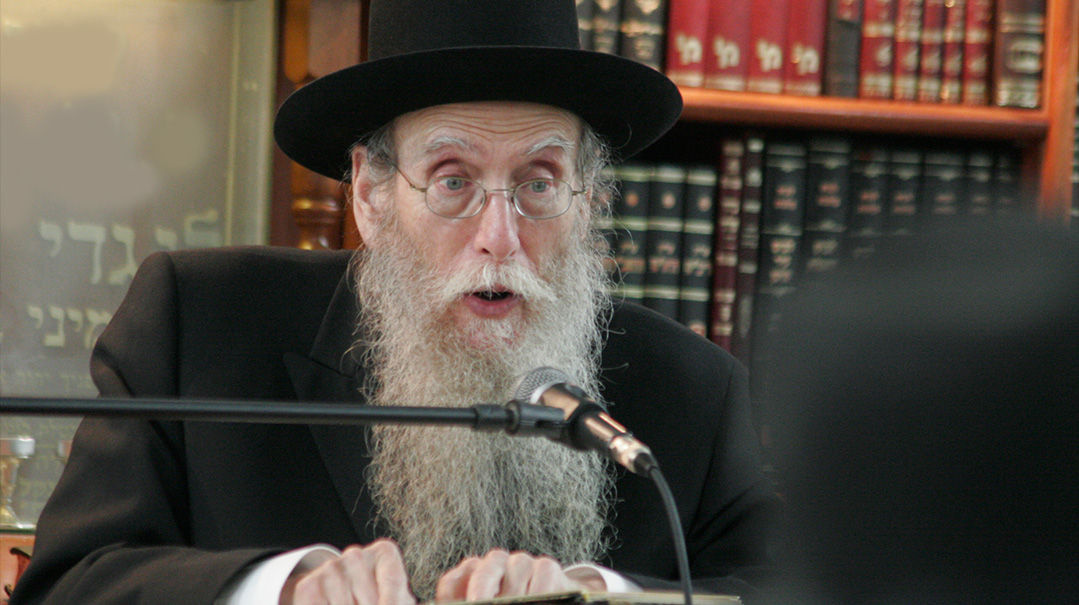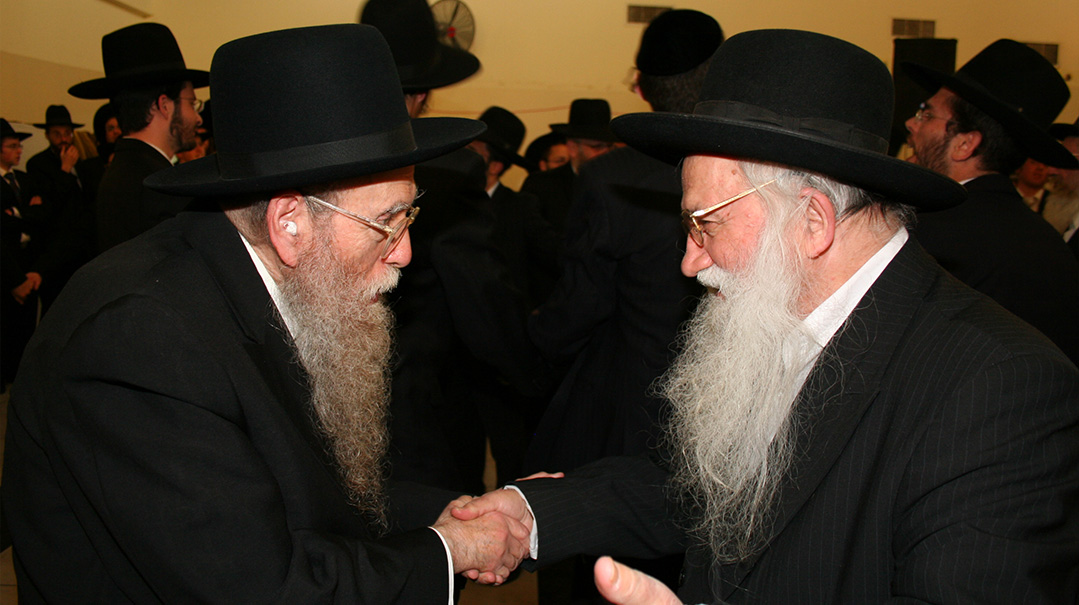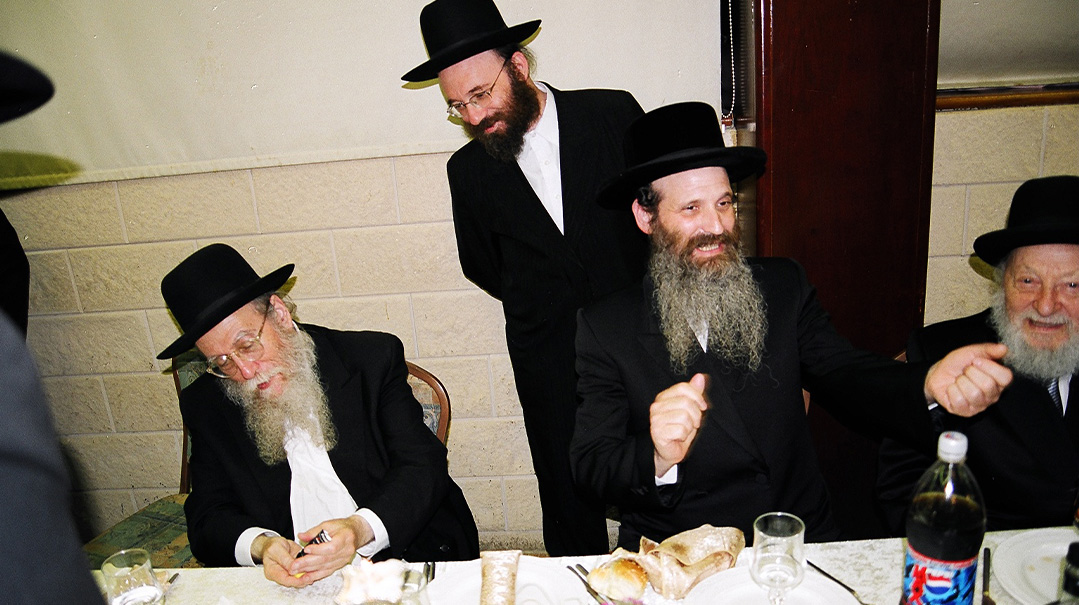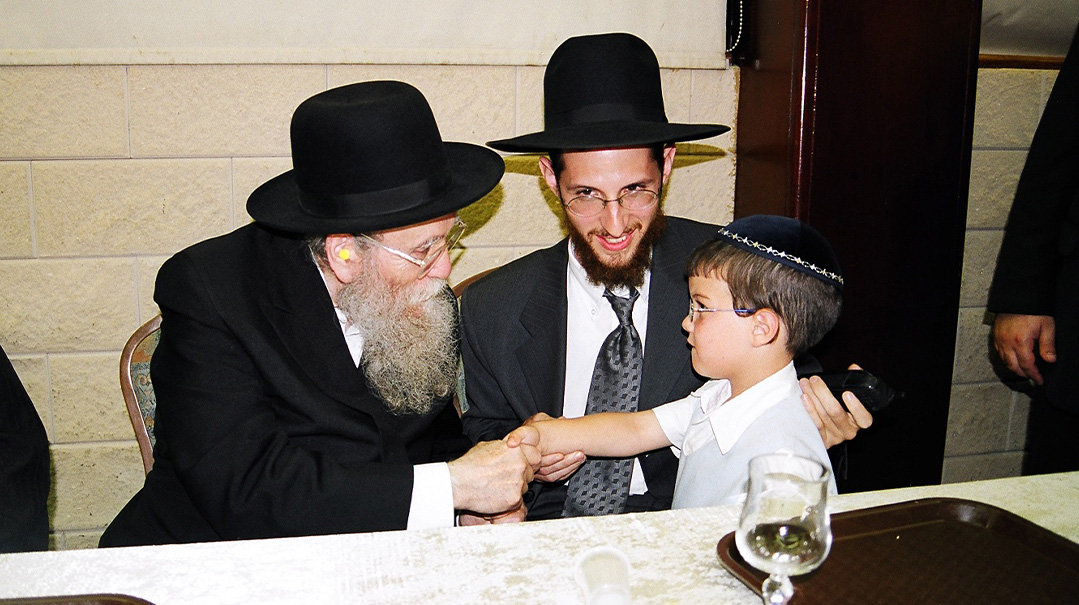Enduring Bond

Ten years later, the impact of Rav Shlomo Brevda hasn’t faded. Talmidim remember his life and his message

Photos: Mattis Goldberg
There’s something about the way they say “Rebbi.” The shoulders sag slightly and a look flashes through their eyes, almost as if they’re searching for something and coming up empty. The word itself seems humbling, as if just mentioning Rebbi has made this paragon of humility reappear, his presence spurning any sense of self-importance.
Rav Shlomo Brevda never held a formal position, never led a shul or delivered shiur in a yeshivah. But a decade after his passing, for so many grown men, accomplished talmidei chachamim, successful business owners, and prominent community leaders, he remains Rebbi.
The Gemara in Berachos (6b) extolls the virtues of a true yarei Shamayim. “Kol ha’olam kulo lo nivra elah l’tzavos l’zeh,” says the Gemara. The whole world was created for the sake of bonding and forging a connection with those who truly fear Heaven. The Gemara may sound cryptic, but it sheds light on Rav Shlomo Brevda’s magnetism.
For decades, Rav Shlomo fielded speaking invitations from just about everywhere. There was a point in time where he was delivering 30 shiurim a week. And while there was no gabbai broadcasting his arrival, or an entourage of talmidim accompanying him, each engagement showcased a packed audience.
How did they know about him? Why did they come?
Kol ha’olam kulo lo nivra elah l’tzavos l’zeh is the only answer. They came because he was a true yarei Shamayim. And the very purpose of Creation demanded that they attach themselves to him.
Path to Greatness
Shlomo Leib Brevda was born in February 1931 to Rav Moshe Yitzchok and Rebbetzin Miriam Brevda. He showed signs of remarkable genius from a very young age. Rav Yitzchok Hutner once conducted a farher for Shlomo’s seventh grade class, and following the exam, Rav Hutner leaned over and pinched the boy’s cheek. A gadol with penetrating vision, Rav Hutner saw what the boy could, and would, become.
Rav Shlomo attended Yeshivas Rabbeinu Yitzchak Elchonon for high school, where he learned under geonim such as Rav Yitzchok Noach Borenstein and Rav Yerucham Gorelick. He then moved on to the Mirrer Yeshivah in Brooklyn, where he considered the rosh yeshivah, Rav Shmuel Brudny, to be his rebbi muvhak.
At the same time, a different branch of the Mirrer Yeshivah thousands of miles away was nearing the end of its legendary hiatus in Shanghai, and the talmidim, along with their rebbeim, were on their way to America. When they arrived in New York and joined the already established Mirrer Yeshivah in Brooklyn, a young Shlomo Brevda was introduced to the Mirrer Mashgiach, Rav Chatzkel Levenstein. Enamored of his saintly character, the bochur forged an inseparable bond with his newfound rebbi.
Just two years after his arrival in America, Rav Chatzkel felt he could no longer tolerate the decadence of the surrounding culture and decided to set sail for Eretz Yisrael. His talmid begged to join, but Rav Chatzkel demurred, and ultimately, Rav Shlomo relented.
Instead, he went to learn in Beth Medrash Govoha under Rav Aharon Kotler, another pivotal step in his continued development. Letters written by Rav Shlomo while in Lakewood describe how enthralled he was by the intense hasmadah that prevailed in the newly established Lakewood Yeshivah. His soul was already kindled, and Rav Aharon Kotler’s fiery neshamah ignited it to a blazing fire. But even as he rose to become a star pupil of Rav Aharon’s, he continued to keep up a correspondence with Rav Chatzkel. Over time, Rav Chatzkel did encourage Rav Shlomo to join him and, ultimately, he left America for Eretz Yisrael.
In Eretz Yisrael, Rav Shlomo discovered yet another rebbi for life — Rav Berel Soloveitchik, son of the Brisker Rav. Rav Shlomo was farhered by the Brisker Rav and was accepted as Rav Berel’s very first talmid.
His move to Eretz Yisrael was providential in another way as well; it brought him in contact with Rav Binyomin Zilber, who frequently attended Rav Chatzkel’s shmuessen. Rav Binyomin, otherwise known as Rav Binyomin Hatzaddik, took note of the impressive young man who seemed especially close with Rav Chatzkel and inquired after him.
He then suggested Shlomo Brevda as a suitable match for Hinda Leah Greenblatt, daughter of the well-known gaon Rav Avraham Baruch Greenblatt. The Rebbetzin tbdlch”t would become a dedicated partner in all of Rav Shlomo’s many accomplishments, and served as an incredibly devoted eishes chayil for their entire life together. It was she who would encourage him to not only speak, but to publish his Torah in print as well.
Rav Shlomo and his rebbetzin settled down to raising their family in Eretz Yisrael, and he simultaneously gained acclaim as a highly knowledgeable talmid chacham and talented orator. Word of mouth spread rapidly — Rav Shlomo Brevda was worth listening to. The crowds would converge upon him and they’d hang on to his every word.

Rav Shlomo with Rav Dov Yaffe, mashgiach of Yeshiva Knesses Chizkiyahu in Kfar Chassidim
Widening Influence
In the year 1968 his life took an unexpected turn. Rav Shlomo developed multiple health complications that necessitated receiving medical treatment abroad. He turned to Rav Chatzkel for direction, and upon his advice traveled to London, England. He knew practically no one but, within days, people began gravitating toward him. Just weeks after his move, the visiting American rabbi had become something of a sensation among young British balabatim.
Rav Shlomo began delivering shiurim, and the room would quickly fill with devoted attendees. He never charged a fee for his speeches; he wouldn’t even ask that his transportation costs be covered. The people sensed his sincerity, and they came in droves.
Rav Shlomo had a particularly unique impact on bnei Torah who had recently joined the workforce or enrolled in college. He was a guiding figure for them, serving as an endless source of spiritual sustenance even in an environment devoid of all things holy.
He was a baal mussar, but his mussar was a mold of its own. He would neither chastise nor encourage; his way was to simply emphasize how grossly we underestimate our potential. And perhaps therein lay the secret to Rav Shlomo’s mesmerizing draw. He believed in people, often more than they believed in themselves. He saw brilliant futures where others saw unassailable obstacles, and he had the chachmah to effectively impart his vision and illuminate a path forward for so many people.
The impact Rav Shlomo had on his London talmidim was unparalleled. Men deeply ensconced in the world of business would become so inspired by him that they sold their homes and moved to Eretz Yisrael where they remained in kollel or took up positions in klei kodesh. While Rav Shlomo didn’t instruct or even imply to his talmidim that he recommended this lifestyle switch, he encouraged and guided those who chose to make this challenging transition. For talmidim who did hold a profession, Rav Shlomo offered the soundest advice, even regarding the mundane vicissitudes of the business world.
Unveiling Layers
An incredible masmid with a brilliantly creative mind, Rav Shlomo could have spent his life authoring seforim bursting with his own chiddushei Torah. But while he did author many seforim, for the most part, they were not his chiddushim. Rav Shlomo was deeply enchanted by the Torah of the Vilna Gaon and dedicated enormous amounts of time and energy to learning and elucidating his Torah.
The works of the Vilna Gaon are enigmatic. The Gaon might write a terse explanation on a pasuk in Mishlei followed by the words “k’mevuar b’Zohar.” But without knowing which line in the Zohar he’s referring to, it’s impossible to really understand what he intends to say. Rav Shlomo would spend hours on these annotations and formulated comprehensive explanations for each word, unveiling the many layers of the Vilna Gaon’s esoteric teachings.
Rav Shlomo’s ability to grant ingress through formerly inaccessible vistas of Torah was a running theme, not only in his seforim but in his shiurim as well.
“When Rav Shlomo would speak about Yom Tov,” says Rav Boruch Gradon, rosh kollel of the Merkaz HaTorah Kollel in Los Angeles, “you could literally feel that Yom Tov. Everything he described came to life.”
Fluent in English, Hebrew, and Yiddish, Rav Shlomo had impeccable communicative skills. He spoke slowly, and his English was punctuated by a dated New York accent that lent a fusion of comfortable familiarity blended with wistful nostalgia. His voice was that of anyone’s grandfather, and his message steeped in the tone of gedolim from a bygone era.
He would use personal examples to describe certain ideas, and these illustrations tended to be rather self-deprecating. In a shiur about Galus Mitzrayim, Rav Shlomo quoted the Chazal that Pharaoh made the men do women’s work and women do men’s work. He went on to paint a dramatic picture of what that could look like.
“My wife once left me in charge of the kitchen. I didn’t know how to turn on the oven. I almost blew up the entire house.”
He was funny, but the humor blended in surreptitiously, complementing, rather than overshadowing, the shiur’s content.

Rav Shlomo attending a simchah. His very presence was uplifting, he was able to inspire simply by being there
In Control
Rav Shlomo suffered from numerous health issues for much of his adult life, but he didn’t let that stop him. At his levayah, Rav Yeruchem Olshin remarked that Rav Shlomo was a true “baal yesurim.” Meaning, said Rav Yeruchem, “he was a baal, a master, over his yesurim. He had complete command over his struggles and deficiencies, not letting them stop his avodas hakodesh.”
Rabbi Gradon saw this firsthand. “Sometimes he was so weak upon arriving at a shiur that I literally had to drag him in.” But, Rabbi Gradon qualifies, the weakness was short-lived. “Somehow, once he began the shiur, his strength would return. A man who moments earlier could barely walk was suddenly suffused with energy.”
If Rav Shlomo was a bubbling wellspring of Torah, he was a fiery pillar when it came to tefillah. His davening was the very depiction of an eved being omed lifnei Rabo. He stood motionless, concentrating intently as he engaged in the most genuine dialogue with the Master of the Universe.
The primacy of tefillah was something Rav Shlomo demonstrated by example, but it was also a topic he spoke about often. As always, he blended his mussar with practical wisdom, stressing that if you can’t daven three intense tefillos a day, at least try to make your Shacharis as vigorous as possible. The impassioned prayers at the day’s start will provide the spiritual energy needed to overcome the many nisyonos thrown your way, he explained.
And just as Rav Shlomo’s shiurim drew throngs, his dynamic tefillos would ring with the same soulful calling, an irrefusable invitation that dozens inexplicably sensed. He would host minyanim in his home and crowds would arrive, some traveling from miles away, to glimpse his authentic dveikus and connect, as best as they could, to the worlds he seamlessly accessed. Visiting roshei yeshivah and mashgichim from Eretz Yisrael would take advantage of their time in London to experience a tefillah with Rav Shlomo.
Rav Shlomo spent approximately 15 years in London, whereupon he returned to Eretz Yisrael. He would continue to visit family in America, ultimately moving to Boro Park for the duration of his life. When traveling between Eretz Yisrael and America, Rav Shlomo would always make a point of stopping in London en route and spending some time with his devoted talmidim. The faithful group of devotees took advantage of these short visits to conduct tefillos together with Rav Shlomo, the spiritual atmosphere that his persona created fortifying the many participants long after his departure.
But it wasn’t just the three established tefillos a day that Rav Shlomo saw as critical. He viewed tefillah as a Jew’s defining leitmotif, a pursuit that remains perennially fixed on the heart and mind of an oved Hashem. He would always encourage people to recite Tehillim.
“Before you call a shadchan,” he would tell older singles, “say a kapitel Tehillim.”
A Promise Fulfilled
Dr. Meir Wikler was a close talmid of Rav Shlomo and would make a point of meeting with him whenever Rav Shlomo was in New York.
During the early years of Dr. Wikler’s career as a family therapist, he was offered a professorship in a major university. The opportunity was enticing but put him in a serious quandary. Did he really want to leave private practice? Was academia really his calling? Unable to decide, he presented the question to his rebbi. But Rav Shlomo seemed puzzled.
“Why would you want to be a professor?” he asked.
“Well, for one thing,” Dr. Wikler explained with a gnawing sense of discomfort, “it’s a prestigious position.”
Rav Shlomo’s expression made it clear he wasn’t going for it.
“Mistama,” he said, eyes twinkling, “if Bilaam were alive today, he’d also be a professor.”
His message was clear: Kavod is not a factor that a Yid takes into consideration when contemplating a career change. Then he continued. “If you want to listen to me, you’ll devote yourself to your clinical practice. That is where you will earn your Olam Haba.”
Dr. Wikler took his rebbi’s advice and never looked back. Rav Shlomo would often introduce him to people as the one who “listened to me and remained a therapist instead of becoming a professor.”
But Rav Shlomo’s ability to offer penetrating insights might have come from something more divine than wisdom. Dr. Wikler shares an uncanny story to illustrate this point.
“Rav Shlomo was once delivering a shiur and mentioned that ‘if someone makes a proper cheshbon hanefesh, just once in his life, he will merit a special siyata d’Shmaya,’ ” Dr. Wikler recalls. “Rav Shlomo then went on to outline what that siyata d’Shmaya would be. ‘Someone will move onto your block and invite you to learn with him. And together you will eventually be mesayem one masechta after another, something you never dreamed was possible.’
“I took his words to heart,” says Dr. Wikler, “and did a proper cheshbon hanefesh.”
Later that week, Rabbi Dr. Aaron Twerski moved around the corner from the Wiklers. Sure enough, within a few days, Rabbi Twerski invited his younger neighbor to learn with him b’chavrusa. After some time, they completed a masechta and Dr. Wikler approached Rav Shlomo to inform him of the fulfilled prophecy. Rav Shlomo looked surprisingly displeased with the news.
“I should have said you’ll finish Shas,” was his response.

Rav Shlomo giving a brachah to a young boy. Ages and stages were meaningless; Rav Shlomo only saw potential
Always Grateful
Rav Shlomo would often emphasize the importance of hakaras hatov. In his sefer Leil Shimurim, a peirush on the Haggadah, Rav Shlomo writes that the mitzvos of Leil HaSeder are meant to deepen and internalize the lessons of gratitude. And, as always, this was something he practiced as much as he preached.
Rav Shlomo once had to accept a talmid’s invitation to move into his home for a few days. Feeling deeply indebted to this talmid for his hospitality, Rav Shlomo wouldn’t make do with a simple thank you. For months thereafter, Rav Shlomo, together with his whole family, would visit this talmid’s home on Friday night to demonstrate what Rav Shlomo deemed adequate appreciation.
During his final illness, when he was forced to be the recipient of many personal favors, Rav Shlomo would make a point of bestowing heartfelt brachos on each benefactor, his physical limitations preventing him from fulfilling the ever-present responsibility of hakaras hatov.
This year, the 26th of Teves marks ten years since his passing. It’s been a decade, but his many talmidim haven’t forgotten his lesson of hakaras hatov. They’re grateful for the Torah he shared, for the advice he distilled, and for the chizuk he offered.
Kol ha’olam kulo lo nivra elah l’tzavos l’zeh.
Above all else, they’re grateful to Rav Shlomo for allowing them to fulfill the purpose of Creation.
(Originally featured in Mishpacha, Issue 945)
Oops! We could not locate your form.







